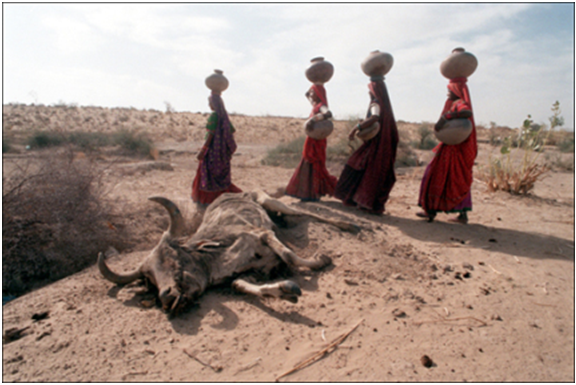Is Just One Good Monsoon the Solution for Drought?

NEW DELHI: After two back to back droughts, the Indian Meteorological Department has projected that the monsoon rains, this year, will be above normal. It expects the rainfall to be evenly distributed across all crop areas. But will this monsoon alone solve the agrarian distress and alleviate the plight of farmers?
The government is very optimistic that “heavy rainfall” will mitigate the effects of sustained drought in the country. But is it that simple?
Year after year, the country suffers from drought and successive governments have failed to redress this issue. Experts have warned over and over again against policies over dependent on a good monsoon; there should be alternatives. Efforts should be made to preserve groundwater levels, and to ensure farmer security after crop failure.
Yogendra Yadav, founding member of Swaraj Abhiyan, said drought is way more than a drinking water crisis. According to him: “Drought is not merely a drinking water crisis; it is a multi-dimensional crisis that affects large parts of rural India. There is food crisis…nutrition crisis; daal has become a luxury for people in Bundelkhand. Crops are severely damaged, and the process of compensation is very slow.”
Indeed, such a multi-dimensional problem requires a multi-dimensional and all-encompassing solution, and a long term strategy. The problem, therefore, must not be seen from the narrow prism of rainfall deficit. A two-pronged strategy is needed: one to resolve the current crisis, and two, to avoid any future crisis of such kind.
Take the case of Marathwada in Maharashtra: 2016 is the third successive year of drought in this region. Water has all but disappeared from rivers, ponds, canals etc. Groundwater levels have been severely degraded because of over-exploitation for “economic purposes”. The desperate demand for water here has led to the rise of water mafias in the region.
Latur area of Marathwada regularly sees conflict due to water. Section 144 of CrPC was imposed in the month of March for “peaceful distribution of water”. There is a glaring trust deficit among the locals because of water. The worsening situation of today is being compared to the great 1972 drought.The administration has still not learnt its lesson and the inability to take long term measures to harvest rainwater, store and save it, reflects the absence of a long-term political vision.
Another less discussed issue is of animals in the affected regions. Domesticated animals are the worst hit by droughts. They are let loose in the open, and they end up dying due to scorching heat and no food. “Cattle are the worst hit, it will be safe to say that there is a cattle famine in India,”Yadav added.
Over-reliance on rainfall is at the core of the problem. Rain-fed agriculture is practiced in majority of cropping area in India (around 55% areas). This puts farmers at the nature’s mercy. The need of the hour is harnessing and adopting alternate sources of water. According to Intergovernmental Panel on Climate Change, measures of water harvesting and conservation can play a big role in mitigating the effects of drought. Micro-irrigation techniques, watershed management, and robust crop insurance schemes will ensure farmer security.
There is also a need to enhance medium and long range forecast capabilities. Effective communication strategy between all the stakeholders involved will go a long way. It is therefore important to set the priorities straight. It is imperative to move from the mindset of short term profits to long term preservations. Creating a sense of collective responsibility is probably the most difficult aspect. Media has a huge role to play in this. They need to push the agenda of farmer welfare effectively on a timely basis. The government, according to Yogendra Yadav, also needs to generate alternate employment opportunities for distressed rural people.
Echoing the sentiments of distressed farmers, P Sainath, senior journalist and author of the book ‘Everybody Loves A Good Drought’, said rainfall deficit is indeed a big problem but it is certainly not the only problem. “If tomorrow there is a good monsoon, the problem is not going away…This drought is not [only] a meteorological drought based on failure of rains.”
Taking a dig at successive governments towards “privatising” water, he further adds: “our cropping pattern is very flawed; we have diverted water from food crops to cash crops; we have diverted water from rural to urban areas; from slums to sky rises…[There is] transfer of resources from poor to rich? Is water a fundamental right for all or a commodity?”
The government must take cognizance of the fact that moving towards water privatisation will be counter-productive in the longer run. Water at affordable rates to the poor is at the core of “socialist” commitments as enshrined in our Constitution. Attempts to privatise water have failed in many parts of the world. Water should remain a social good and must never be made into an economic good.
The upcoming monsoon will certainly provide much needed relief to people but there should be a long term strategy to cope with disasters such as droughts. “Water must be declared a human right and the right of species who share the planet with us, Sainath said.



